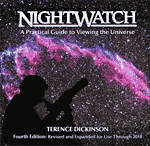|
3
|
Moon at perigee (closest to Earth) at 13h UT (357,251 km; 33.5').
|
|
3
|
New Moon at 19:23 UT. Start of lunation 1057.
|
|
6
|
Moon near Pollux at 10h UT (evening sky).
|
|
7
|
Moon near Beehive cluster (M44) at 10h UT (50° from Sun, evening sky).
• Messier 44 (Wikipedia)
|
|
7
|
Mercury at inferior conjunction with the Sun at 15h UT. Mercury passes into the morning sky (not visible).
• Inferior Conjunction (Wikipedia)
|
|
8
|
Moon near Mars at 1h UT (evening sky). Mag. +1.5.
|
|
9
|
Moon near Regulus at 2h UT (evening sky).
|
|
9
|
Venus at superior conjunction with the Sun at 4h UT. Passes into the evening sky (not visible).
• Superior Conjunction (Wikipedia)
|
|
9
|
Moon near Saturn at 7h UT (evening sky). Mag. +0.7.
|
|
10
|
First Quarter Moon at 15:04 UT.
|
|
13
|
Moon near Spica at 8h UT (evening sky).
|
|
16
|
Moon at apogee (farthest from Earth) at 18h UT (distance 406,228 km; angular size 29.4').
|
|
17
|
Moon very near Antares at 5h UT (evening sky). Occultation visible from southern South America.
• Occultation of Antares (IOTA)
|
|
18
|
Full Moon at 17:30 UT. The full Moon of June is called the "Rose Moon", "Flower Moon" or "Strawberry Moon".
• Full Moon Names (Wikipedia)
|
|
20
|
Moon near Jupiter at 14h UT (morning sky). Mag. -2.7. Jupiter displays the largest and most detailed planetary disk of all the planets. Even a small telescope will reveal Jupiter's cloud bands and its four largest moons known as the Galilean moons (discovered by Galileo in 1610). Jupiter has a total of 63 moons.
|
|
20
|
Pluto at opposition at 16h UT. Mag. 14. Requires at least a 10-inch telescope and a very dark sky to view.
• Pluto in 2008 (Sky & Telescope)
|
|
20
|
June solstice at 23:59 UT. The time when the Sun reaches the point farthest north of the celestial equator marking the start of summer in the Northern Hemisphere and winter in the Southern Hemisphere.
• June Solstice (Wikipedia)
|
|
26
|
Last Quarter Moon at 12:10 UT.
|
|
30
|
Moon near the Pleiades at 8h UT (evening sky).
• The Pleiades (Wikipedia)
|
|
All times Universal Time (UT). USA Eastern Summer Time = UT - 4 hours.
|


